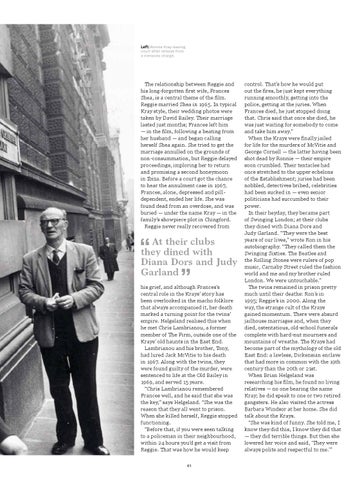Left: Ronnie Kray leaving court after release from a menaces charge.
The relationship between Reggie and his long-forgotten ¿ rst wife, Frances Shea, is a central theme of the ¿ lm. Reggie married Shea in 1965. In typical Kray style, their wedding photos were taken by David Bailey. Their marriage lasted just months; Frances left him — in the ¿ lm, following a beating from her husband — and began calling herself Shea again. She tried to get the marriage annulled on the grounds of non-consummation, but Reggie delayed proceedings, imploring her to return and promising a second honeymoon in Ibiza. Before a court got the chance to hear the annulment case in 1967, Frances, alone, depressed and pilldependent, ended her life. She was found dead from an overdose, and was buried — under the name Kray — in the family’s showpiece plot in Chingford. Reggie never really recovered from
At their clubs they dined with Diana Dors and Judy Garland his grief, and although Frances’s central role in the Krays’ story has been overlooked in the macho folklore that always accompanied it, her death marked a turning point for the twins’ empire. Helgeland realised this when he met Chris Lambrianou, a former member of The Firm, outside one of the Krays’ old haunts in the East End. Lambrianou and his brother, Tony, had lured Jack McVitie to his death in 1967. Along with the twins, they were found guilty of the murder, were sentenced to life at the Old Bailey in 1969, and served 15 years. “Chris Lambrianou remembered Frances well, and he said that she was the key,” says Helgeland. “She was the reason that they all went to prison. When she killed herself, Reggie stopped functioning. “Before that, if you were seen talking to a policeman in their neighbourhood, within 24 hours you’d get a visit from Reggie. That was how he would keep 61
control. That’s how he would put out the ¿ res, he just kept everything running smoothly, getting into the police, getting at the juries. When Frances died, he just stopped doing that. Chris said that once she died, he was just waiting for somebody to come and take him away.” When the Krays were ¿ nally jailed for life for the murders of McVitie and George Cornell — the latter having been shot dead by Ronnie — their empire soon crumbled. Their tentacles had once stretched to the upper echelons of the Establishment; juries had been nobbled, detectives bribed, celebrities had been sucked in — even senior politicians had succumbed to their power. In their heyday, they became part of Swinging London; at their clubs they dined with Diana Dors and Judy Garland. “They were the best years of our lives,” wrote Ron in his autobiography. “They called them the Swinging Sixties. The Beatles and the Rolling Stones were rulers of pop music, Carnaby Street ruled the fashion world and me and my brother ruled London. We were untouchable.” The twins remained in prison pretty much until their deaths: Ron’s in 1995; Reggie’s in 2000. Along the way, the strange cult of the Krays gained momentum. There were absurd jailhouse marriages and, when they died, ostentatious, old-school funerals complete with hard-nut mourners and mountains of wreaths. The Krays had become part of the mythology of the old East End: a lawless, Dickensian enclave that had more in common with the 19th century than the 20th or 21st. When Brian Helgeland was researching his ¿ lm, he found no living relatives — no one bearing the name Kray; he did speak to one or two retired gangsters. He also visited the actress Barbara Windsor at her home. She did talk about the Krays. “She was kind of funny. She told me, I know they did this, I know they did that — they did terrible things. But then she lowered her voice and said, ‘They were always polite and respectful to me.’”
